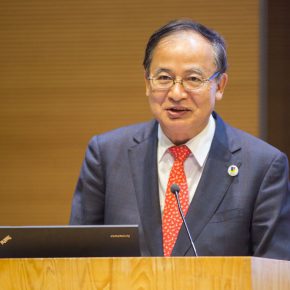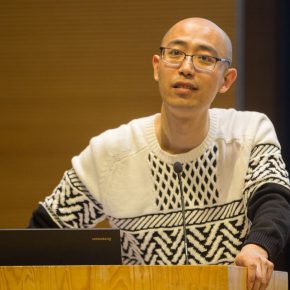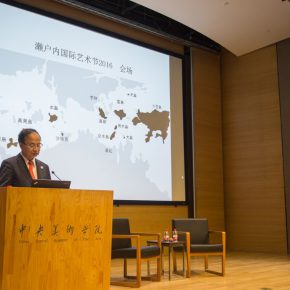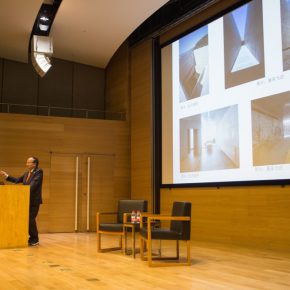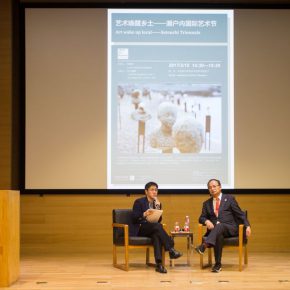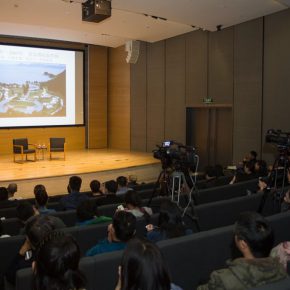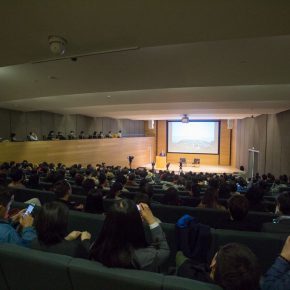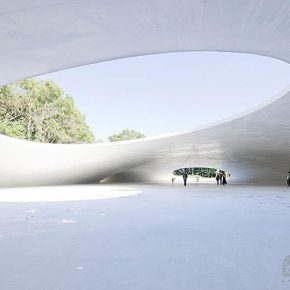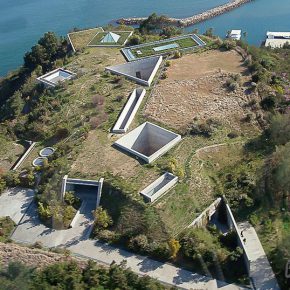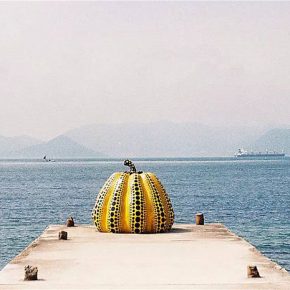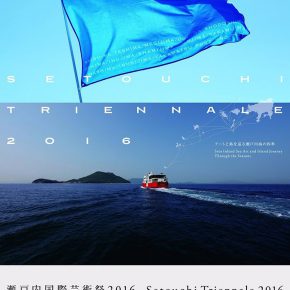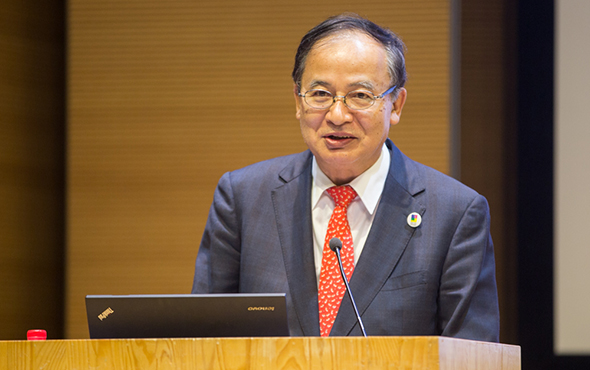
On the afternoon of March 19, 2017, Fram Kitagawa, one of the most influential curators of the international art community, the founder of the Echigo-Tsumari Art Field and Setouchi Triennale gave a lecture entitled “Art Awake up Local – Setouchi Triennale” at the CAFA Art Museum, started from Setouchi Triennale to explain the practice of the arts promoting the regional revitalization. The lecture was hosted by Prof. Wu Jian’an from the School of Experimental Art, CAFA, and Zhao Gang, a researcher at the Institute of Japan at the Chinese Academy of Social Sciences served as the interpreter.
Setouchi Triennale started in 2010, with a form of triennale to invite the well-known Japanese and foreign curators and contemporary artists, including Yayoi Kusama, Tadao Ando, Hiroshi Sugimoto, Atelier Ryo Abe, Tadanori Yokoo, Shinro Ohtake, Kazuyo Sjima, Ryue Nishizawa, Chiharu Shiota, Hiroshi Senju, Tatsuo Miyajima, Keisuke Yamaguchi, etc., and the artists created works depending on the local environment, creating an artistic atmosphere and improving the appearance of the area, so as to attract visitors from all over the world, through an exchange with the residents of the islands, to develop tourism, making the island’s economy regain vitality. Setouchi Triennale gained a wide range of international influence with the unprecedented size of the triennale and the high-level works, thus becoming an iconic project to promote the local remodel through the power of contemporary art in Japan.
In 2011, a tsunami was triggered by a strong earthquake in Japan, which inresulted many people losing their homes and families. Fram Kitagawa held an art festival in Seto Inland Sea, trying to appease the pain caused by the lost families and also trying to help people re-understand the relationship between the ocean and humans. Setouchi Triennale is composed of 12 islands with individual charm, the isolated beaches, surrounded by clear and blue beaches. However, these islands are not always cozy, as Fram Kitagawa introduced the fact because of the erosion of sulfite, Naoshima and Inujima islands’ vegetation is damaged and bare. In the 1960s and 1970s, Toshima was confronted with many problems because of the illegal dumping of industrial waste, and it was not solved by the Japanese government until recently; Oshima is an island where there are many cases of leprosy; in addition to the ecological problems, it is necessary to solve the problems of depopulation and the elderly people that have been left behind who have broken away from society. He said that, “Through art we can transform, so that these islands can be re-transformed by art, help people to focus on the water and the sea.”
As one of the most famous architects in Japan, Tadao Ando created many excellent works for the Setouchi Triennale. Fram Kitagawa started from Tadao Ando’s Chichu Art Museum, and the underground building’s lighting depends on the sun penetrating the artificially-cut geometric openings of the hillside. His work is like a camera, through which people can see the space and the sea which is the charm of Tadao Ando’s building.
Art plays an important role in the revitalization of the place and Fram Kitagawa was committed to the association with the art and rural construction, both the chigo-Tsumari Art Field and Setouchi Triennale are the faith adhered to by him. Setouchi Triennale advertises the “simultaneity of folk-customs, Japan No, fiesta, fudoki”, and the features of “synchronicity of modern art, architecture and drama”, so that it is innovated by artists, writers or architects, and even cooperates with the residents of the island to create works.
The artists of Setouchi Triennale emphasize the participation of the communities of the islands and the inhabitants of the island are involved in the special artworks or gallery guides. There are seasonal cafes, guest houses and bike rental points, and the commercial expansion is due to the increasing number of tourists. At the same time, it holds a variety of children-related summer camp activities on the islands, on the one hand, it is designed to make people felt happy, on the other hand, it is also the continuation of the triennale. Because the event was held, many islanders who had left returned to the island where they had once lived.
After that, Fram Kitagawa spent a great deal of time introducing the various works of art on the islands: Yayoi Kusama’s sculpture of a pumpkin covered by yellow dots, Teshima Art Museum designed by the architect Ryue Nishizawa and artist Rei Naito, Shinro Ohtake’s Naoshima Bath which can be used, the artist Christian Boltanski set up more than 400 wind chimes in the forest, the Megijima Theater concentrated the memories of Manhattan old theater, the room rotated 90 degrees was created by Oiwa Oscar, the Chinese artist Lin Tianmiao combined the old daily necessities and tools that were no longer used to create the “Rotation – Revolution”, the artist Tanya Preminger used granite and lawns to pile a 650-centimeter-high hill entitled “Stratum”, the “Sculpture of Black Sea Bream” which is made up of the collected empty beverage and plastic bottles, as well as other garbage and waste from the residents... through the creation by the worldwide artists, these islands which are gradually abandoned live together with the art and more exciting vitality bursts out.
Text by Lin Jiabin, translated by Chen Peihua and edited by Sue/CAFA ART INFO
Photo by Hu Sichen/CAFA ART INFO
(Works diverted from the network)


